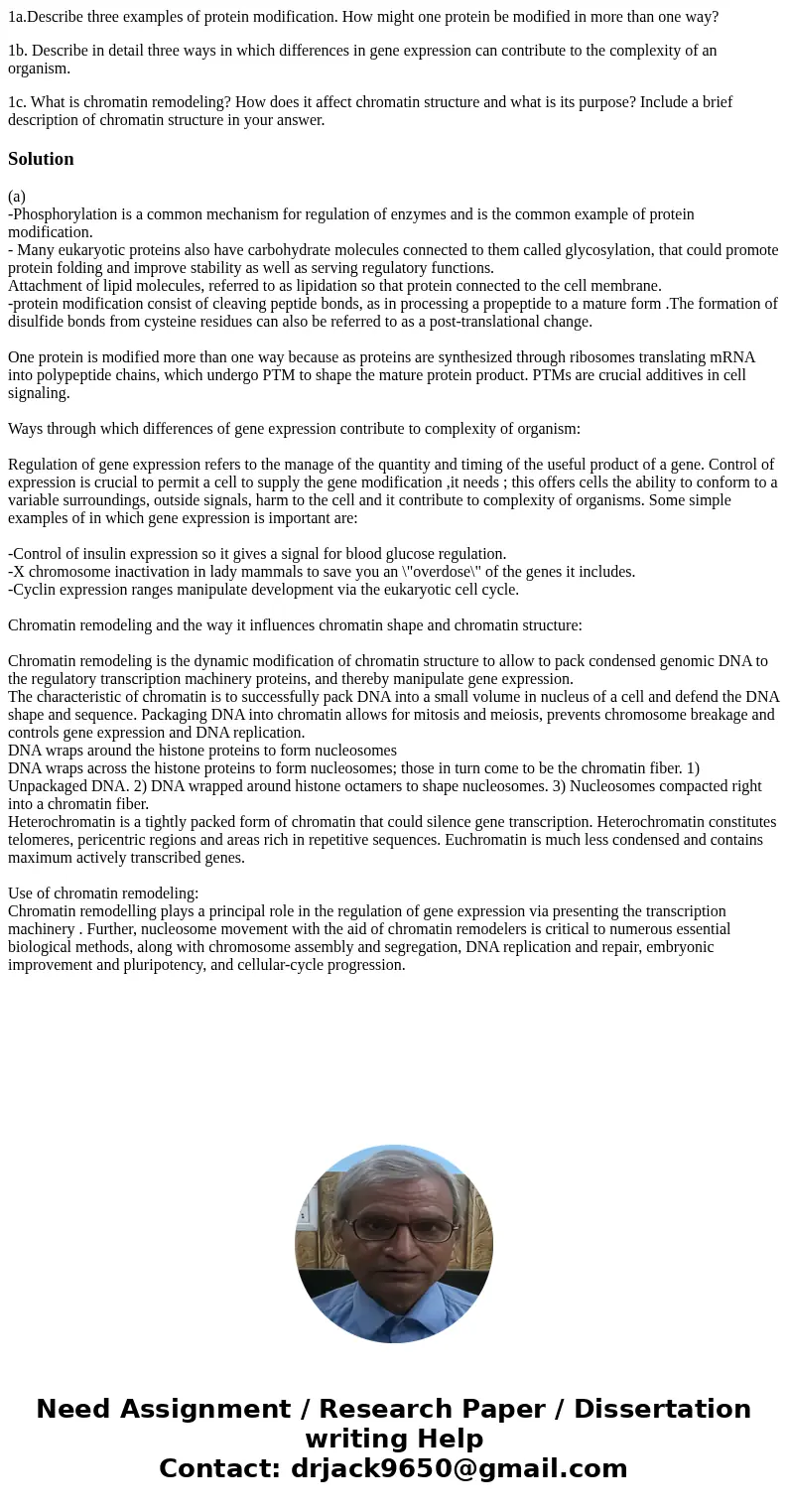1aDescribe three examples of protein modification How might
1a.Describe three examples of protein modification. How might one protein be modified in more than one way?
1b. Describe in detail three ways in which differences in gene expression can contribute to the complexity of an organism.
1c. What is chromatin remodeling? How does it affect chromatin structure and what is its purpose? Include a brief description of chromatin structure in your answer.
Solution
(a)
-Phosphorylation is a common mechanism for regulation of enzymes and is the common example of protein modification.
- Many eukaryotic proteins also have carbohydrate molecules connected to them called glycosylation, that could promote protein folding and improve stability as well as serving regulatory functions.
Attachment of lipid molecules, referred to as lipidation so that protein connected to the cell membrane.
-protein modification consist of cleaving peptide bonds, as in processing a propeptide to a mature form .The formation of disulfide bonds from cysteine residues can also be referred to as a post-translational change.
One protein is modified more than one way because as proteins are synthesized through ribosomes translating mRNA into polypeptide chains, which undergo PTM to shape the mature protein product. PTMs are crucial additives in cell signaling.
Ways through which differences of gene expression contribute to complexity of organism:
Regulation of gene expression refers to the manage of the quantity and timing of the useful product of a gene. Control of expression is crucial to permit a cell to supply the gene modification ,it needs ; this offers cells the ability to conform to a variable surroundings, outside signals, harm to the cell and it contribute to complexity of organisms. Some simple examples of in which gene expression is important are:
-Control of insulin expression so it gives a signal for blood glucose regulation.
-X chromosome inactivation in lady mammals to save you an \"overdose\" of the genes it includes.
-Cyclin expression ranges manipulate development via the eukaryotic cell cycle.
Chromatin remodeling and the way it influences chromatin shape and chromatin structure:
Chromatin remodeling is the dynamic modification of chromatin structure to allow to pack condensed genomic DNA to the regulatory transcription machinery proteins, and thereby manipulate gene expression.
The characteristic of chromatin is to successfully pack DNA into a small volume in nucleus of a cell and defend the DNA shape and sequence. Packaging DNA into chromatin allows for mitosis and meiosis, prevents chromosome breakage and controls gene expression and DNA replication.
DNA wraps around the histone proteins to form nucleosomes
DNA wraps across the histone proteins to form nucleosomes; those in turn come to be the chromatin fiber. 1) Unpackaged DNA. 2) DNA wrapped around histone octamers to shape nucleosomes. 3) Nucleosomes compacted right into a chromatin fiber.
Heterochromatin is a tightly packed form of chromatin that could silence gene transcription. Heterochromatin constitutes telomeres, pericentric regions and areas rich in repetitive sequences. Euchromatin is much less condensed and contains maximum actively transcribed genes.
Use of chromatin remodeling:
Chromatin remodelling plays a principal role in the regulation of gene expression via presenting the transcription machinery . Further, nucleosome movement with the aid of chromatin remodelers is critical to numerous essential biological methods, along with chromosome assembly and segregation, DNA replication and repair, embryonic improvement and pluripotency, and cellular-cycle progression.

 Homework Sourse
Homework Sourse